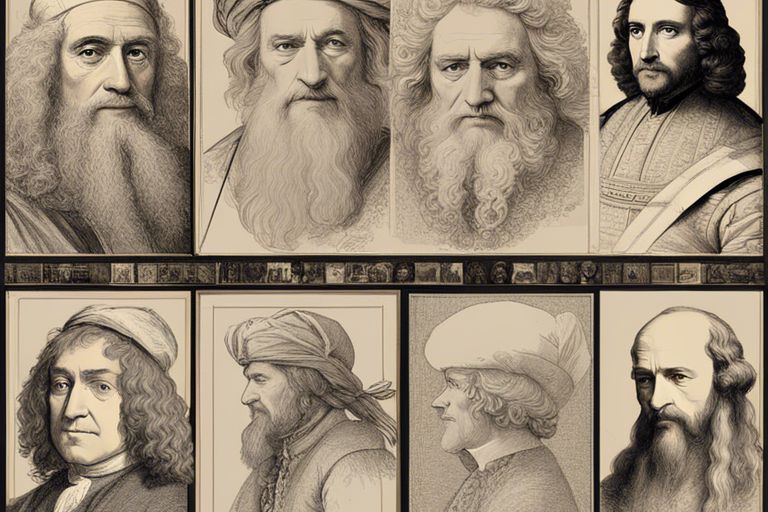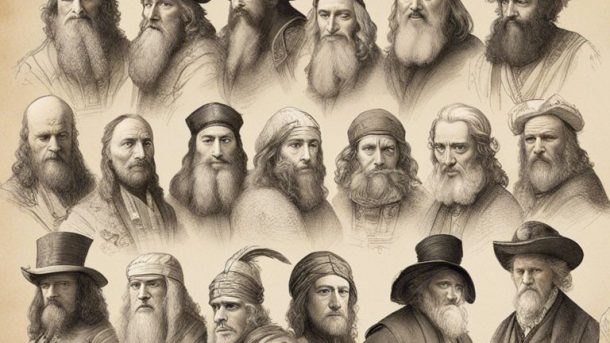There’s a rich history of sketch artistry that has captured the imagination of people throughout the ages. From the detailed drawings of Leonardo da Vinci to the playful sketches of Pablo Picasso, these artists have honed their craft to leave a lasting impact on the art world. In this post, you’ll discover some of the most famous sketch artists in history and learn about their unique styles and contributions to the world of art. So grab your sketchbook and let’s investigate the fascinating world of sketch art!

Key Takeaways:
- Leonardo da Vinci: Known for his detailed and anatomically accurate sketches.
- Pablo Picasso: Renowned for his innovative and abstract sketching techniques.
- M.C. Escher: Recognized for his intricate and mind-bending sketches that explore mathematical concepts.
The Renaissance Masters
To truly appreciate the art of sketching, you must probe into the works of the Renaissance masters. During this period, artists like Leonardo da Vinci and Michelangelo showcased their unparalleled skill and creativity through their sketches, laying the foundation for the future of art.
Leonardo da Vinci: The Original Sketch Artist
An artist ahead of his time, Leonardo da Vinci used sketching as a way to explore his ideas and concepts. By translating his observations of the natural world onto paper, he created a visual diary of his thoughts and experiments. His sketches not only depicted the human form with unparalleled accuracy but also probed into scientific studies, engineering designs, and futuristic inventions.
Michelangelo’s Expressive Drawings
Original and emotive, Michelangelo’s drawings were a testament to his unparalleled talent and creativity. His sketches captured the human form in a way that conveyed raw emotion and dramatic intensity. Michelangelo’s expressive drawings revealed the inner workings of his mind, showcasing his unique vision and artistic process.
The intensity and dynamism in Michelangelo’s sketches were unmatched, showcasing his ability to infuse life and emotion into his drawings. Each stroke revealed his deep understanding of the human anatomy and his unparalleled skill in capturing movement and expression.
The Age of Caricature
Even as far back as the 18th century, caricature was becoming a popular art form. Artists began creating exaggerated, often humorous, depictions of prominent figures in society. This marked the beginning of the Age of Caricature, a period where satire and social commentary were expressed through art in a playful yet impactful manner.
Honoré Daumier: The Father of French Caricature
For Honoré Daumier, caricature was more than just a form of art – it was a powerful tool for political and social critique. Daumier, a French artist and printmaker, is often referred to as the Father of French Caricature for his bold and incisive portrayals of the political figures and societal issues of his time. Through his works, Daumier fearlessly challenged authority and brought attention to the injustices faced by the common people.
Thomas Nast: The American Cartoonist
Daumier may have been the Father of French Caricature, but across the Atlantic, Thomas Nast was making waves as the preeminent American cartoonist of the 19th century. Nast’s caricatures and political cartoons were instrumental in shaping public opinion during a time of great social and political change in the United States. His illustrations played a significant role in exposing corruption and advocating for social reform.
This brings us to Thomas Nast: the American political cartoonist known for his influential work in the 19th century. Nast used his talent to advocate for political reform and expose corruption. His caricatures were so powerful that they are credited with helping to bring down the corrupt Tammany Hall political machine in New York City.
This era not only showcased the artistic talents of individuals like Daumier and Nast but also highlighted the significant impact that caricature and political cartoons could have on shaping public opinion and driving social change.

The Impressionist Era
Despite the Impressionist movement being primarily known for its paintings, several artists of this era were also renowned for their sketching abilities. Sketching allowed these artists to capture moments in a quick and spontaneous manner, providing a glimpse into their artistic process and creativity.
Claude Monet’s Quick Sketches
One artist known for his quick sketches during the Impressionist Era was Claude Monet. These sketches were often done en plein air (outdoors) and served as studies for his later paintings. Monet’s loose and expressive strokes in his sketches captured the essence of a scene or subject, showcasing his keen observation skills and ability to translate fleeting moments onto paper.
Edgar Degas’s Dancer Drawings
To many, Edgar Degas is synonymous with his intricate drawings of dancers. Degas’s dancer drawings were not only studies of movement and form but also insights into the daily lives of ballerinas in Paris during that time. His sketches revealed a fascination with capturing the grace and poise of the dancers, showcasing his mastery in depicting human anatomy and movement.
Drawings of dancers by Edgar Degas often featured behind-the-scenes moments, such as dancers practicing, stretching, or interacting with one another. These sketches provided a behind-the-curtain view of the ballet world, offering viewers a more intimate and authentic perspective on the lives of the dancers.
The Modern Era
Many renowned artists emerged in the Modern Era, each contributing their unique style and perspective to the world of sketch art. Two prominent figures from this period are Pablo Picasso and Salvador Dalí.
Pablo Picasso’s Cubist Sketches
For Pablo Picasso, sketching was not just a preliminary exercise but a vital part of his artistic process. His Cubist sketches, characterized by their geometric shapes and abstract forms, revolutionized the art world in the early 20th century. Picasso’s sketches captured the essence of his subjects in a way that challenged traditional artistic norms, paving the way for new interpretations of reality.
Salvador Dalí’s Surrealist Drawings
Sketches played a significant role in Salvador Dalí’s artistic endeavors as well. Known for his Surrealist drawings, Dalí’s sketches often depicted fantastical and dream-like imagery that challenged the viewer’s perception of reality. Dalí’s sketches served as a visual diary of his subconscious thoughts and desires, offering a glimpse into the inner workings of his mind.
Dalí’s Surrealist drawings were not only visually striking but also held symbolic meanings that invited viewers to probe deeper into the artist’s psyche. By exploring the depths of his imagination through his sketches, Dalí pushed the boundaries of traditional art and paved the way for new possibilities in the world of surrealism.
The Cartoonists
After exploring some of the greatest sketch artists in history, let’s explore into the world of cartoonists. These individuals have a unique ability to capture humor and satire in their illustrations, often creating iconic characters and stories that resonate with audiences for generations.
Charles Addams: The Master of Macabre
For those intrigued by the darker side of humor, you’ll find Charles Addams’ work both fascinating and delightfully twisted. Addams is best known for creating ‘The Addams Family’, a group of bizarre and macabre characters that have become beloved figures in pop culture. His intricate and morbidly humorous illustrations have left a lasting impact on the world of cartoons, showcasing a unique blend of wit and morbidity.
Robert Crumb: The Underground Comix Legend
For fans of counterculture and underground art, Robert Crumb is a name that stands out in the world of cartooning. Known for his controversial and boundary-pushing work in the underground comix scene of the 1960s and 70s, Crumb’s art challenged societal norms and explored taboo subjects with humor and raw honesty. His most famous creation, Fritz the Cat, became a symbol of the underground comix movement and solidified Crumb’s reputation as a legendary figure in the world of alternative comics.
One interesting fact about Robert Crumb is that he was one of the key figures in the underground comix movement that pushed the boundaries of traditional comic art. His art style, characterized by intricate cross-hatching and attention to detail, set a new standard for autobiographical and satirical comics, influencing generations of artists to come.
Legend has it that Robert Crumb’s work continues to inspire and provoke thought, challenging conventional ideas of what comic art can be. His legacy as an underground comix legend remains unparalleled, making him a true icon in the world of cartooning.
The Contemporary Scene
Chris Riddell: The British Cartoonist and Illustrator
All you need to do is take one look at the works of Chris Riddell to understand why he is a renowned name in the world of sketch art. His intricate and whimsical illustrations have graced countless books, bringing characters and stories to life in a way that captivates both children and adults alike. Riddell’s distinctive style and keen eye for detail have earned him multiple prestigious awards, solidifying his place as a prominent figure in contemporary sketch art.
Roz Chast: The New Yorker Cartoonist
Cartoonist Roz Chast is a household name, especially for those who enjoy the wit and humor found in the pages of The New Yorker. Her distinctive, quirky style and satirical take on everyday life make her creations instantly recognizable and endlessly entertaining. Chast’s work often probes into themes of anxiety, family dynamics, and the absurdities of modern living, striking a chord with readers who appreciate a blend of humor and astute observations.
The quirky and relatable nature of Chast’s cartoons has garnered her a loyal following and numerous accolades throughout her career. Her ability to find humor in the mundane and often chaotic aspects of life sets her apart as a master of the craft, making her a standout figure in the world of contemporary sketch art.
To wrap up
Ultimately, sketch artists have played a significant role in the art world throughout history, capturing moments with precision and creativity. From the detailed sketches of Leonardo da Vinci to the whimsical drawings of Beatrix Potter, each artist brings a unique perspective and skill to their work. By exploring the works of famous sketch artists, you can gain insight into different techniques and styles that have influenced the art world for generations. To continue exploring the world of drawing art, you can check out 12 amazingly talented Drawing Artists to get Inspired by.
Q: Who is considered one of the most famous sketch artists of all time?
A: Leonardo da Vinci is widely regarded as one of the most famous sketch artists throughout history. His detailed and anatomically accurate sketches demonstrate his incredible artistic talents.
Q: Which artist is known for their quick and expressive sketches?
A: Rembrandt van Rijn, a Dutch artist from the 17th century, is known for his quick and expressive sketches that capture the essence of his subjects. His sketches often serve as studies for his paintings and reveal his exceptional skill in capturing light and shadow.
Q: Who is a modern sketch artist known for their innovative and experimental approach?
A: Pablo Picasso, a renowned 20th-century artist, is celebrated for his innovative and experimental approach to sketching. His sketches often demonstrate his ability to deconstruct and reconstruct forms in a unique way, showcasing his revolutionary artistic vision.




